This is the raising gang.There are usually two people up in the air, and several more down in the street. Their job is to get the pieces from the street, put them in place and usually stuff one or two bolts in the open holes - just enough to secure the members, and then they lift up and set the next piece.
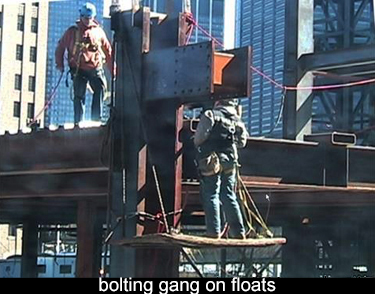 They are followed by the bolting gang, and they, of course, fill all of the holes with bolts and the torque, the bolts. It's a good idea to have a testing program to manually check the torque on the bolts. The ironworker in the foreground is standing on a float - a very, very simple device, easily manhandled and tied to the steel. This is very traditional. You'll see many, many floats in the building supporting the iron workers. In addition, the ironworkers are tied off. They're wearing a harness and a safety devices to prevent an accidental fall. The ironworker in the background is walking on metal pans, which are usually called Q deck, and they are laid out across the floor beams as quickly as the steel is erected. That's also done as a safety feature.
They are followed by the bolting gang, and they, of course, fill all of the holes with bolts and the torque, the bolts. It's a good idea to have a testing program to manually check the torque on the bolts. The ironworker in the foreground is standing on a float - a very, very simple device, easily manhandled and tied to the steel. This is very traditional. You'll see many, many floats in the building supporting the iron workers. In addition, the ironworkers are tied off. They're wearing a harness and a safety devices to prevent an accidental fall. The ironworker in the background is walking on metal pans, which are usually called Q deck, and they are laid out across the floor beams as quickly as the steel is erected. That's also done as a safety feature.
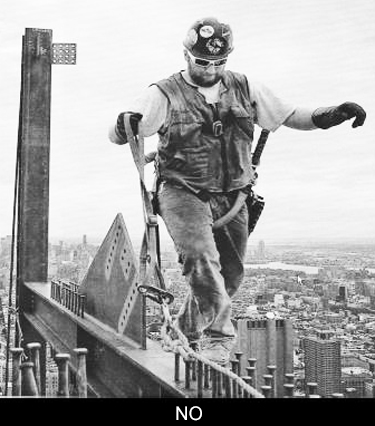 I included this photo. It's a fascinating photo, but it's a good picture of what not to do. This ironworker is walking on, not just the top flange of the steel -which he's called upon to do very often- but he is working on the top of the shear connectors - which is terrible practice. I can't imagine why he's even doing it. The only reason he might be doing it is that he knows he's tied off and he has that fall protection, The presence of the fall protection does not excuse bad practice. What he's doing is really unforgivable.
I included this photo. It's a fascinating photo, but it's a good picture of what not to do. This ironworker is walking on, not just the top flange of the steel -which he's called upon to do very often- but he is working on the top of the shear connectors - which is terrible practice. I can't imagine why he's even doing it. The only reason he might be doing it is that he knows he's tied off and he has that fall protection, The presence of the fall protection does not excuse bad practice. What he's doing is really unforgivable.
I'm not sure why the sheer connectors appear here. This could be a bay which has some kind of diagonal bracing and requires interaction with the concrete. Whatever her, the need is, these Shear connectors can be installed in the field. Traditionally, that's what's done. Never in the factory, which presents this obvious, avoidable hazard to the Ironworkers. Let me show you how this is traditionally done, at least in bridge construction.
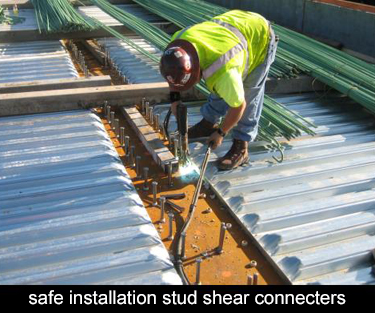 Here is a detail of the installation of the shear connectors. This surround shape is a ceramic ferrule. The ironworker inserts the stud with a sheer connector inside his ferrule and brings it to the location where he wants to install it. When he squeezes the trigger an arc is generated. That melts the surfaces and automatically plunges the stud into that molten pool, which is held in place by this ceramic ferrule. Afterwards, you need to break away the ferrule and dispose of it. That should be removed before you place the concrete. There are many other Hardware devices which take advantage of this technology and allow you to install them very, very quickly and effectively.
Here is a detail of the installation of the shear connectors. This surround shape is a ceramic ferrule. The ironworker inserts the stud with a sheer connector inside his ferrule and brings it to the location where he wants to install it. When he squeezes the trigger an arc is generated. That melts the surfaces and automatically plunges the stud into that molten pool, which is held in place by this ceramic ferrule. Afterwards, you need to break away the ferrule and dispose of it. That should be removed before you place the concrete. There are many other Hardware devices which take advantage of this technology and allow you to install them very, very quickly and effectively.
We reached a point where the foundation wall is partially constructed and is under construction throughout the entire site. You can see that the cranes within this site are now basically trapped inside the hole. This is the time when you need to shift the responsibility onto tower cranes. You assemble the tower cranes, and when they are completely assembled, they will actually lift out all these other devices.
Tower cranes will now come into use. The crawler crane in the foreground has been used in the construction of the foundation, and also in the early steel erection, but very quickly, the steel will be out of his reach. The crane itself is going to be in the way. Tower cranes will be used to finish the project. On this project, internally installed tower cranes will be used. They actually climb on the steel frame of the building. I'll show you exactly what that process is like.
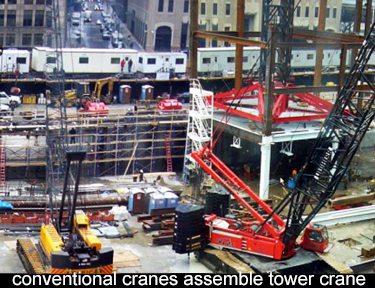 This photo shows the initial installation, the very start of the construction of the tower crane. You can see sections of the Tower. The red frame below is the bottom support. It's that bottom support, which is actually attached to the four columns and will ride up in the building.
This photo shows the initial installation, the very start of the construction of the tower crane. You can see sections of the Tower. The red frame below is the bottom support. It's that bottom support, which is actually attached to the four columns and will ride up in the building.
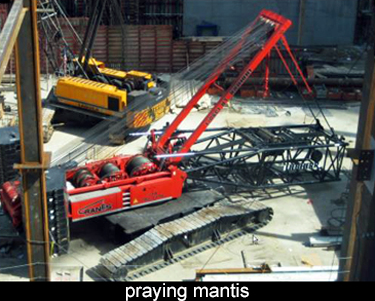 Every time I see this photo, I'm reminded of a praying mantis after the couple have mated. The female turns around and bites off the male's head. That's about what's taking place in this picture. After the crawler crane erected the tower crane, the tower crane turns around and literally bite off its head. All of the boom is missing, and the tower crane will continue to devour this until it's broken into small elements and lifted out of the excavation.
Every time I see this photo, I'm reminded of a praying mantis after the couple have mated. The female turns around and bites off the male's head. That's about what's taking place in this picture. After the crawler crane erected the tower crane, the tower crane turns around and literally bite off its head. All of the boom is missing, and the tower crane will continue to devour this until it's broken into small elements and lifted out of the excavation.